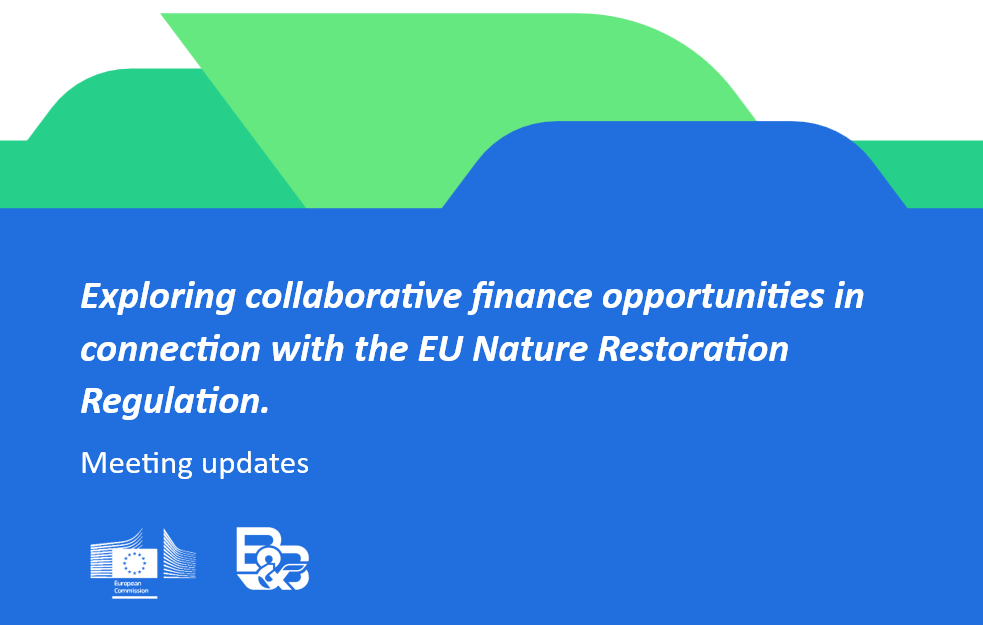Exploring collaborative finance opportunities in connection with the EU Nature Restoration Regulation.

date: 28/05/2025
The Finance and Biodiversity (F&B) Community, convened by the EU B&B Platform since 2017, held 2 meetings (1 online and 1 in-person) for members, exploring the scaling up of financial instruments in high-opportunity sectors in the context of the EU Nature Restoration Regulation.
Financial institution members highlighted the need for a stronger business case for nature, clear regulatory guidelines, defined roles for public and private sectors, and common language and metrics to assess nature investment impacts aligned with the EU Taxonomy.
Here are the key messages from the meetings:
Key policies and initiatives to increase biodiversity finance
Nature Restoration Regulation
Policy officers from the European Commission’s DG Environment, outlined the EU Nature Restoration Regulation (NRR) targets and financing framework. The NRR complements existing EU nature laws and requires Member States to develop National Restoration Plans (NRPs) by 2026, with restoration measures starting immediately. Member States must quantify and describe restoration measures, non-deterioration measures and timing for implementation, and interplay with climate and energy plans.
Eight times higher yield with nature investment
While the EU’s financing framework does not establish a dedicated fund for nature restoration, existing EU funds such as LIFE programme and InvestEU can be redirected to support restoration efforts. The EU Commission’s impact assessment indicates that over €100 billion in current funds could be mobilised to support restoration if Member States prioritise these efforts. The regulation is designed to deliver significant economic returns, with every euro invested generating €8 in benefits. The Commission is also exploring nature credit schemes.
EIB urges public-private finance innovation
A financial advisor at the European Investment Bank (EIB), presented findings from their report on financing nature investments and overcoming investment barriers, highlighting a significant funding gap. Public funding dominates the biodiversity finance landscape, with minimal private investment or funding. There is a need for blended finance models that combine public subsidies with revenues to make restoration projects more viable and attract sources of repayable capital. The EIB is working on developing new funding and financial instruments, such as biodiversity credits and risk-sharing mechanisms.
Nature finance initiatives and examples
Landscape approach for collective investment
The Netherlands Enterprise Agency (RVO) presented their Nature Finance Program and Strategies to scale-up Payments for Ecosystem Services, highlighting its evolution from raising awareness to investing with nature-positive impact. The program focuses on reforming harmful financial flows, using a landscape approach, regulating ecosystem services, and ensuring collective investment through ex-ante landscape analysis.
Need for (joint) targets and biodiversity assessment
The Finance for Biodiversity (FfB) Foundation presented two initiatives: ‘Finance for Nature Positive – Building a Working Model’ paper providing a framework for how private finance can contribute to nature-positive, and the ‘Private Finance and Investments for Nature Positive’ project, funded by Global Environment Facility, to help financial institutions measure biodiversity impacts, set targets and identify restoration investment opportunities.
Scaling potential of six proven practices by members
Members of the Platform presented examples from the Business models and investments for nature and summary paper. These examples, including green bonds and sustainability-linked loans, highlight the significant growth potential of privately funded nature investments. For these investments to scale, these investments would benefit from de-risking public finance and blended finance mechanisms, clear standards and indicators, and improved policy incentives such as expanding the EU Taxonomy to include a broader range of sustainability projects like circular economy and biodiversity to align with evolving environmental challenges.
Unlocking nature restoration joint opportunities across high-opportunity areas
Joint opportunities were explored to restore nature across four areas: urban ecosystems, agriculture, forestry, and value chains. Key outcomes include recognising biodiversity’s resilience value in urban ecosystems, promoting landscape-level projects in agriculture, enhancing sustainable procurement and risk management in forestry, and focusing on harm reduction and policy incentives to scale restorative practices in value chains. Cross-sector collaboration and long-term financing mechanisms were identified as essential for scaling nature-positive initiatives.
Moving forward with collaborative finance
The events concluded with a strong call for public and private financial institutions to collaborate in addressing the nature finance gap. Participants of this meeting expressed a keen willingness to work together with governments to support nature restoration, through efforts such at the EU Nature Restoration Regulation, with the aim of identifying effective public-private finance mechanisms (i.e., biodiversity credits, blended finance structures, stacking finance flows) that can be scaled across Europe. With the groundwork laid for future discussions in 2025, the F&B Community is poised to play a key role in advancing financial opportunities to support EU’s biodiversity targets.
Workshop series: Assessing Contributions to Positive Biodiversity Impact
To support positive biodiversity impact, the EU B&B Platform Workstream Finance, in collaboration with the Workstream Methods and the Finance for Biodiversity (FfB) Foundation, is hosting a series of exclusive online workshops for members of the Finance & Biodiversity Community and FfB working groups. Each session focuses on a different biodiversity assessment tool, exploring its key challenges and opportunities. The insights and conclusions from the series will be included as a separate chapter in one of our publications.
Reference materials:
- Investing in nature-based solutions, EIB, 2023
- Overcoming investment barriers in the forest sector: lessons learned from nine cases in Europe, EIF, Bioregions and EIB, 2024
Are you interested in joining the Finance & Biodiversity Community? Please get in touch: info@nextgreen.nl (Finance Workstream Lead under the EU Business & Biodiversity Platform) or register here indicating ‘Join F&B Community’.
